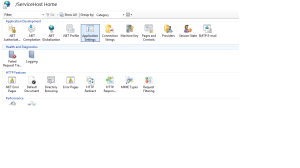Navigate to Sites - SCSMWebContentServer - ServiceHost
Double click Application Settings. From Actions select add and add the following value.
Name: MaximuminstanceCount
Value: 5000


#################Script Start ####################################
$RootMS = "RMSName"
$Minutes = 90
$Comment = "Unknown"
#Setting up SCOM connection
Import-Module OperationsManager
$null = New-ScomManagementGroupConnection -ComputerName $RootMS
Add-PSSnapin "Microsoft.EnterpriseManagement.OperationsManager.Client" -ErrorAction SilentlyContinue
$eventLog = New-Object System.Diagnostics.EventLog("Operations Manager")
$eventLog.Source = "Maintenance Mode"
$Servers = GC "C:\Reboots\input.txt"
Function Out($output)
{
Out-File -Filepath "C:\Reboots\output.txt" -InputObject $output -Append
}
Out "############### Starting Script at $(Get-Date) ##########################"
foreach($Server in $Servers)
{
$output = "Starting for $Server on $(Get-date)"
Out $output
###Putting the agent and cluster in maintenance mode###########
$agent = Get-ScomAgent | Where-Object { $_.DisplayName –eq $Server -or $_.ComputerName -eq $Server -or $_.PrincipalName -eq $Server }
if(!$agent) { Write-Host "ERROR: $Server is not a monitored system in SCOM." -ForeGroundColor Red; Set-Location $originalPath; return }
$Server = $agent.PrincipalName
$startTime = (Get-Date).ToUniversalTime()
$endTime = $startTime.AddMinutes($Minutes)
if(($clusters = $agent.GetRemotelyManagedComputers())) {
$clusterNodeClass = Get-SCOMClass -Name Microsoft.Windows.Cluster.Node
foreach($cluster in $clusters) {
#$clusterObj = Get-SCOMClass -Name Microsoft.Windows.Cluster | Get-ScomMonitoringObject -Criteria "Name='$($cluster.ComputerName)'"
$clusterobj = Get-SCOMClass -Name Microsoft.Windows.Cluster | Get-SCOMClassInstance | ?{$_.displayname -eq $cluster.ComputerName}
if($clusterObj) {
$clusterObj.ScheduleMaintenanceMode($startTime,$endTime,"PlannedOther",$Comment,"Recursive")
$nodes = $clusterObj.GetRelatedMonitoringObjects($clusterNodeClass)
if($nodes) {
foreach($node in $nodes) {
Out "Putting $node into maintenance mode."
$eventLog.MachineName = $node.Name
$eventLog.WriteEntry("The server entered into maintenance mode $(if($Server -notcontains $node.Name){"on behalf of $Server"}).`r`n`r`nDuration:`t$Minutes minutes`r`nReason:`t$Comment","Information",42)
}
}
}
Out "Putting $($cluster.Computer) into maintenance mode."
New-MaintenanceWindow -StartTime $startTime -EndTime $endTime -MonitoringObject $cluster.Computer -Reason PlannedOther -Comment $Comment
}
}
else {
Out "Putting $Server into maintenance mode."
$eventLog.WriteEntry("The server entered into maintenance mode.`r`n`r`nDuration:`t$Minutes minutes`r`nReason:`t$Comment","Information",42)
New-MaintenanceWindow -StartTime $startTime -EndTime $endTime -MonitoringObject $agent.HostComputer -Reason PlannedOther -Comment $Comment
}
#####Sending commands to the server###########
$Task = Get-SCOMTask -DisplayName "Reboot Computer"
$Overrides = @{Arguments = '"$Target/Property[Type="MicrosoftWindowsLibrary7585010!Microsoft.Windows.Computer"]/PrincipalName$" "true"'}
$Instance = Get-SCOMClassInstance | ?{$_.Name -eq $agent.name}
Out "Starting task to reboot $($Instance.Displayname) at $(Get-Date)"
Start-SCOMTask -Task $Task -Override $Overrides -Instance $Instance
}
Out "############### Script Complete at $(Get-Date) #########################"
#################Script End ####################################
